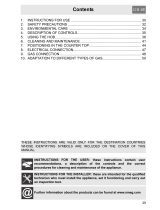
27
Instructions for the User
5. USING THE HOB
5.1 Gas hob
Before lighting the hob burners, check that the flame-spreader crowns are
correctly in place with their respective burner caps, making sure that the
holes A in the flame-spreaders are aligned with the plugs and
thermocouples.
Before using the electric plates or the barbecue (if included) for the first
time, pre-heat them to the maximum temperature long enough to burn off
any manufacturing oily residues which could give the food a bad smell.
The pan stand B is for use with woks. To prevent damage to the cooker
hob, it comes complete with a raised pan stand C. This must be placed
under pans with a diameter bigger than those indicated in the table in point
"5.3 Pan diameters". The pan stand C must never be used on the ultra-
rapid burner.
The burner controlled by each knob is shown next to
the knob. The appliance is equipped with an
electrical ignition device. Simply press the knob and
turn it counterclockwise to the maximum flame
symbol, until the burner lights. If it does not light in
the first 15 seconds, position the knob on 0 and wait
at least 60 seconds before trying to light it again.
On valved models, once the burner is lit, keep the knob pressed for a few
seconds to give the thermocouple time to heat up. The burner may go out
when the knob is released: in this case, the thermocouple has not heated
up sufficiently. Wait a few moments and repeat the operation keeping the
knob pressed for a longer time. This is not necessary on burners that are
not equipped with thermocouple. Once the burner is lit, the flame can be
adjusted as needed. Always check that the control knobs are in the (off)
position when you finish using the hob.
If the burners should go out accidentally, after about 20 seconds a safety
device will be tripped, cutting off the gas supply, even if the gas tap is
open. In this case, turn the knob to the OFF position and wait at least 60
seconds before trying to light the burner again.



















